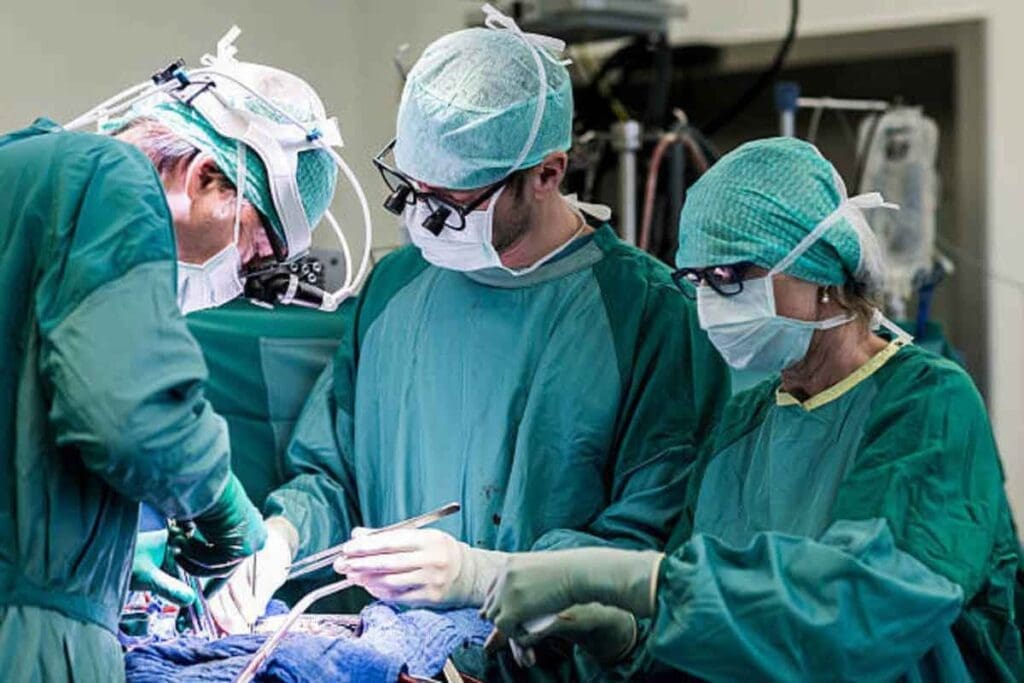Last Updated on November 26, 2025 by Bilal Hasdemir

After a heart attack, patients need quick and effective treatment. Cardiac procedures and surgeries are key in emergency care and managing heart health long-term.Discover common types of surgery for heart attack, how they help, and recovery expectations.
Every year, millions of cardiac procedures are done worldwide. This shows how important surgery for heart attack patients is. Treatments like thrombolysis, coronary angioplasty, and CABG are used to fix blood flow and stop further damage.
Key Takeaways
- Cardiac procedures and surgeries are vital after a heart attack.
- Treatments like thrombolysis and coronary angioplasty help restore blood flow.
- Coronary artery bypass graft surgery (CABG) is a common surgical intervention.
- Effective treatment can significantly improve long-term heart health.
- Liv Hospital’s patient-centered approach ensures effective recovery through advanced cardiac surgeries and treatments.
Understanding Heart Attacks and the Need for Surgical Intervention

A heart attack happens when blood flow to the heart is blocked. This can damage the heart muscle. Knowing what happens during a heart attack helps understand why surgery might be needed.
What Happens During a Heart Attack
During a heart attack, the coronary arteries get blocked. This blockage stops the heart muscle from getting oxygen and nutrients. The damage depends on where and how much the artery is blocked.
Symptoms of a heart attack include chest pain and shortness of breath. Pain in the arms, back, neck, jaw, or stomach can also occur. Spotting these symptoms early is key to quick medical help.
When Surgery Becomes Necessary
Surgery is needed after a heart attack if the heart muscle is badly damaged. Procedures like coronary artery bypass grafting (CABG) or percutaneous coronary intervention (PCI) may be required. The decision to have surgery depends on the patient’s health and the damage.
Emergency vs. Planned Cardiac Procedures
Cardiac procedures can be emergency or planned. Emergency surgeries are done right away for serious conditions. Planned surgeries are scheduled in advance based on the patient’s condition.
In conclusion, knowing about heart attacks and surgery is key for patients. Recognizing heart attack signs and the need for surgery helps get timely medical help. This can improve treatment outcomes.
Percutaneous Coronary Intervention (PCI): The First Line of Defense

PCI, or Percutaneous Coronary Intervention, is a lifesaving procedure. It has changed how we treat heart attacks by opening blocked arteries quickly and effectively. This method is key in cardiac care, greatly improving patient results.
The American Heart Association says PCI is a key intervention for heart attacks. It can be done in emergencies to get blood flowing to the heart again.
“PCI is a vital tool in the management of acute coronary syndromes, including heart attacks,” as emphasized by cardiologists.
How Angioplasty Works
Angioplasty is a part of PCI that uses a balloon to widen a blocked artery. This is often done with stenting, where a small mesh tube is placed to keep the artery open. Together, angioplasty and stenting are very effective in getting blood flowing again.
The Procedure Process
The PCI procedure starts with a catheter being put into the blocked artery, usually through the groin or wrist. The balloon is then inflated to open the artery, and a stent is placed to keep it open. This is all done with the help of advanced imaging to make sure it’s done right.
Using drug-eluting stents has made PCI even more successful. These stents release medicine that stops new tissue from growing, keeping the artery open longer.
Recovery and Success Rates
Recovery from PCI is quick, with most patients going home in a day. PCI has high success rates, greatly improving survival and quality of life for heart attack patients. A study in a leading cardiology journal found that
“The timely application of PCI in the setting of a heart attack can dramatically alter the course of the disease.”
PCI is a major step forward in treating heart attacks. It’s a powerful tool to restore heart function and improve patient outcomes.
Coronary Artery Bypass Grafting (CABG): Surgery for Heart Attack Patients
CABG surgery is a lifeline for those who have had a heart attack. It involves grafting a healthy blood vessel onto a blocked artery. This restores blood flow to the heart.
The Bypass Procedure Explained
The CABG procedure is complex. First, the patient is given general anesthesia. This ensures they don’t feel pain during the operation.
The surgeon then makes an incision in the chest to access the heart. The heart is either stopped, or the surgery is done on a beating heart. This depends on the situation.
Grafting involves taking a healthy blood vessel from another part of the body. It’s usually from the leg, arm, or chest. The vessel is attached to the aorta and the coronary artery below the blockage. This bypasses the blockage, allowing blood to flow freely to the heart muscle.
Traditional vs. Minimally Invasive Approaches
CABG can be done in two ways. Traditional CABG involves a larger incision in the chest. This method is used for more complex cases or when multiple bypasses are needed.
Minimally invasive CABG uses smaller incisions. It results in less trauma to the body, quicker recovery times, and less scarring. But it’s only for less complex cases and requires a skilled surgeon.
| Aspect | Traditional CABG | Minimally Invasive CABG |
| Incision Size | Larger incision | Smaller incisions |
| Recovery Time | Generally longer | Typically shorter |
| Scarring | More noticeable scarring | Less noticeable scarring |
| Complexity | Suitable for complex cases | Best for less complex cases |
Recovery Timeline
The recovery time for CABG surgery varies. It depends on the individual’s health, the procedure’s complexity, and any complications. Patients usually spend several days in the hospital after surgery.
Full recovery can take several weeks to a few months. During this time, patients follow a rehabilitation program. This includes physical activity, dietary changes, and stress management. It helps ensure the best outcome.
Stent Placement and Atherectomy: Maintaining Arterial Blood Flow
Stent placement and atherectomy are key procedures for keeping arteries open after a heart attack. They help restore and keep the coronary arteries healthy. This reduces the chance of more heart problems.
Types of Cardiac Stents
Cardiac stents are small, mesh tubes used in the coronary arteries. They keep the arteries open. There are many types, each for different needs and conditions.
- Bare Metal Stents: These are the first stents made from metal mesh. They support the artery to stay open.
- Drug-Eluting Stents: These stents have medication that slowly releases. It helps prevent the artery from narrowing again.
Drug-Eluting vs. Bare Metal Stents
Choosing between drug-eluting and bare metal stents depends on several factors. These include the patient’s health, the blockage’s severity, and the risk of complications.
“Drug-eluting stents reduce restenosis rates compared to bare metal stents,” a study found. But, they need longer dual antiplatelet therapy. This is something to consider for patients.
Atherectomy Techniques for Plaque Removal
Atherectomy removes plaque from arteries. There are various techniques used:
- Rotational Atherectomy: A rotating device grinds away plaque.
- Laser Atherectomy: A laser breaks down plaque.
- Orbital Atherectomy: A device orbits the plaque, removing it through sanding.
Each method has its benefits. The choice depends on the plaque’s type and the patient’s condition.
Heart Valve Repair and Replacement Procedures
Damage to heart valves after a heart attack might need surgery. This could be a repair or replacement to help the heart work better. Heart valve surgery is key for those who have had a heart attack.
Identifying Valve Damage After a Heart Attack
It’s important to check for valve damage after a heart attack. Damage can cause heart failure or irregular heartbeats. Tests like echocardiography help see if surgery is needed.
Echocardiography uses sound waves to show the heart. Doctors use it to check valve function and spot problems. Sometimes, more tests, like cardiac catheterization, are needed to check the heart valves.
Surgical Valve Replacement Options
If valve damage is found, surgery might be needed. There are different ways to do this, like open-heart surgery or less invasive methods.
- Mechanical valves are strong and last long. But they need lifelong blood thinner treatment to avoid clots.
- Bioprosthetic valves are made from animal tissue. They might be better for those who can’t take blood thinners. But, they might not last as long and could need to be replaced.
Transcatheter Aortic Valve Replacement (TAVR)
TAVR is a new way to fix aortic valve stenosis without open-heart surgery. It uses a catheter to put in a new valve.
TAVR is a good choice for those at high risk of surgery complications. It has improved a lot, with better results and quicker recovery times.
TAVR has less risk of problems, shorter hospital stays, and quicker recovery. But it’s not for everyone. Talking to a doctor is important before deciding on TAVR.
Implantable Cardiac Devices for Post-Heart Attack Management
Implantable cardiac devices are key to maintaining heart health after a heart attack. They help keep the heart working well. This ensures the heart functions efficiently and effectively.
Pacemakers for Rhythm Control
Pacemakers are small devices implanted under the skin. They help control the heartbeat by sending electrical impulses. They treat abnormal heart rhythms, or arrhythmias, that can happen after a heart attack.
Pacemakers can be programmed to adjust the heart rate for different activities. This helps the heart rate match the body’s needs.
Implantable Cardioverter Defibrillators (ICDs)
ICDs are more advanced than pacemakers. They can deliver a shock to the heart if a dangerous arrhythmia is detected. They are great for patients at high risk of sudden cardiac death after a heart attack.
ICDs continuously monitor the heart’s rhythm. They can step in when needed to prevent serious problems.
Left Ventricular Assist Devices (LVADs)
LVADs are mechanical devices implanted in the heart. They support the heart’s function and improve blood flow. They are used in patients with severe heart failure, including those who have had a heart attack.
LVADs can significantly improve the quality of life for these patients. They help the heart pump blood more effectively.
In conclusion, devices like pacemakers, ICDs, and LVADs are vital for heart health after a heart attack. Each device has its own role. They can be lifesaving for patients with specific heart conditions.
Cardiac Ablation for Post-Heart Attack Arrhythmias
Cardiac ablation is a key treatment for arrhythmias after a heart attack. It uses energy to destroy abnormal heart pathways. This helps fix irregular heartbeats.
Correcting Irregular Heartbeats through Ablation
Cardiac ablation finds and fixes the heart areas causing arrhythmia. It uses thin, flexible tubes called catheters. These tubes are inserted through a leg vein and guided to the heart.
Once the problem area is found, energy is applied. This destroys the tissue, causing the irregular heartbeat.
Key Benefits of Cardiac Ablation:
- Reduces or eliminates arrhythmia symptoms
- Improves quality of life
- Decreases the need for long-term medication
Radiofrequency vs. Cryoablation Techniques
Cardiac ablation uses two main techniques: radiofrequency and cryoablation. Radiofrequency ablation heats the heart tissue with high-frequency energy. This creates lesions that stop the abnormal signals.
Cryoablation freezes the tissue instead. Both methods aim to disrupt the abnormal signals.
| Technique | Description | Advantages |
| Radiofrequency Ablation | Uses high-frequency electrical energy to heat tissue | Effective for many types of arrhythmias, a well-established technique |
| Cryoablation | Uses extreme cold to freeze tissue | Less risk of damaging surrounding tissue, useful for certain arrhythmias |
Recovery and Effectiveness
Recovery from cardiac ablation varies. Most patients stay in the hospital overnight. The procedure can greatly reduce or eliminate arrhythmia symptoms.
Studies show it improves life quality for those with arrhythmias. The success rate depends on the arrhythmia type and heart health. Generally, it’s safe and effective for post-heart attack arrhythmias.
Cardiac Resynchronization Therapy for Heart Failure
Cardiac Resynchronization Therapy (CRT) has changed how we treat heart failure. It gives hope to those with this condition. Heart failure happens when the heart can’t pump blood well, causing fatigue and breathlessness. CRT helps by pacing both ventricles to improve pumping.
Improving Heart Function
CRT makes the heart work better by pacing the ventricles in sync. This boosts the heart’s pumping power, improving blood flow. It also cuts down on heart failure symptoms.
Studies show CRT can greatly improve life quality for heart failure patients. It reduces hospital stays and death rates.
A device is implanted to send electrical impulses to both ventricles. This device, called a CRT device, can be a pacemaker (CRT-P) or a pacemaker and defibrillator combo (CRT-D).
CRT-P vs. CRT-D Devices
The choice between CRT-P and CRT-D depends on the patient’s needs. CRT-P devices offer pacing therapy for ventricular synchronization. They’re for patients needing resynchronization but not at risk for dangerous arrhythmias.
CRT-D devices add the shock function for life-threatening arrhythmias. They’re for patients at higher risk of such arrhythmias.
Candidates for Resynchronization Therapy
Not all heart failure patients need CRT. The decision to use a CRT device is based on several factors. These include the severity of symptoms, ventricular dyssynchrony, and overall health.
Patients with moderate to severe symptoms and ventricular dyssynchrony are usually considered. A heart team’s evaluation is key in deciding if CRT is right for a patient.
Emerging Cardiac Procedures and Technologies
New technologies and techniques are changing heart treatment. Medical research is leading to better treatments and a better life for heart patients.
Robotic-Assisted Cardiac Surgery
Robotic-assisted cardiac surgery is a big step forward. It uses robots to do complex surgeries with more precision and less harm. The benefits include:
- Smaller cuts mean less scarring and lower infection risk
- More precise and complex surgeries are possible
- Less blood loss and fewer transfusions are needed
- Patients can leave the hospital sooner and recover faster
Stem Cell Therapies for Heart Repair
Stem cell therapies aim to fix damaged heart tissue after a heart attack. They use the stem cells’ ability to heal to improve heart function. Research focuses on:
- Mesenchymal stem cells for their healing properties
- Induced pluripotent stem cells for growing new heart tissue
- Stem cell-derived exosomes for treatment
Artificial Intelligence in Cardiac Care
Artificial intelligence (AI) is making cardiac care better. AI analyzes data to help doctors make better choices. It’s used for:
- Creating personalized treatment plans based on risk
- More accurate diagnoses through image analysis
- AI-powered monitoring to catch heart problems early
These new procedures and technologies are very promising. They could greatly improve heart care in the future.
Conclusion: The Future of Heart Attack Treatment
Heart attack treatment is getting better, thanks to new advances in cardiac care. Procedures like percutaneous coronary intervention and coronary artery bypass grafting are now more effective. This means patients have more options to help them recover.
Research and trials, like the STICH and SYNTAX studies, are leading the way. They are helping to shape the future of heart attack treatment. New technologies, such as stem cell therapies and robotic-assisted surgery, are also on the horizon.
We can look forward to even better care for heart attack patients. The future is promising, with discoveries and technologies making a big difference. This progress will help save more lives and improve outcomes for everyone.
FAQ
What is the difference between emergency and planned cardiac procedures?
Emergency cardiac procedures happen right after a heart attack. They aim to get blood flowing again. Planned procedures, on the other hand, are set up in advance to fix underlying heart issues.
How does angioplasty work during a Percutaneous Coronary Intervention (PCI)?
Angioplasty uses a balloon to open up blocked arteries. This helps blood flow back to the heart.
What is the recovery timeline for Coronary Artery Bypass Grafting (CABG) surgery?
CABG surgery recovery takes 6 to 12 weeks. This time can vary based on the surgery type and individual recovery.
What are the types of cardiac stents used in stent placement procedures?
Cardiac stents come in two types. Drug-eluting stents release medicine to prevent blockages. Bare metal stents don’t release medicine.
How does Transcatheter Aortic Valve Replacement (TAVR) differ from traditional valve replacement surgery?
TAVR is a less invasive procedure that replaces the aortic valve through a catheter. Traditional surgery, on the other hand, is open-heart surgery.
What is the purpose of Implantable Cardioverter Defibrillators (ICDs) in post-heart attack management?
ICDs detect and correct dangerous heart rhythms. They send an electric shock to get the heart beating normally again.
How does Cardiac Resynchronization Therapy (CRT) improve heart function?
CRT makes the heart pump better by coordinating the left and right ventricles. This improves the heart’s efficiency.
What are the benefits of robotic-assisted cardiac surgery?
Robotic-assisted surgery has many advantages. It uses smaller incisions, results in less blood loss, and leads to faster recovery.
What is the role of artificial intelligence in cardiac care?
Artificial intelligence helps in cardiac care by analyzing data, predicting outcomes, and improving treatment plans.
How do pacemakers control heart rhythm after a heart attack?
Pacemakers send electrical impulses to make the heart beat at a normal rate. This helps control the heart rhythm.
What is the difference between CRT-P and CRT-D devices?
CRT-P devices provide pacing therapy. CRT-D devices offer both pacing and defibrillation therapy for serious heart rhythm problems.
What are the candidates for Cardiac Resynchronization Therapy?
People with heart failure, a low ejection fraction, and ventricular dyssynchrony are good candidates for CRT.
References
- Lane, B. C., et al. (2015). Time from symptoms to carotid endarterectomy or stenting and the effect on outcomes: A systematic review and meta-analysis. Stroke, 46(10), 2899-2905. https://www.ncbi.nlm.nih.gov/pmc/articles/PMC4765730/






